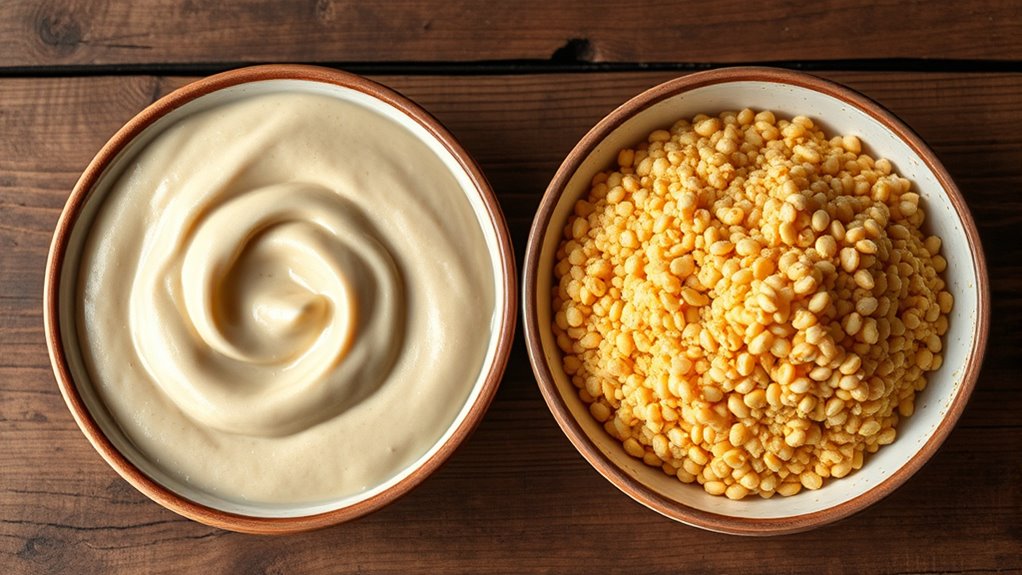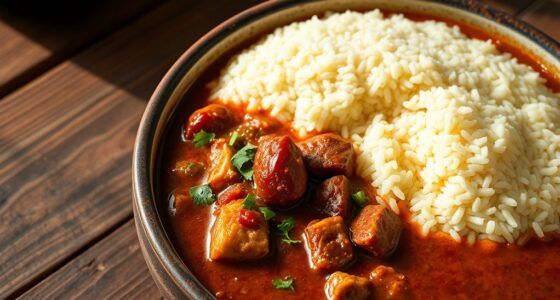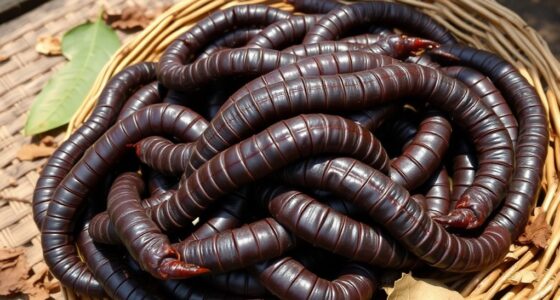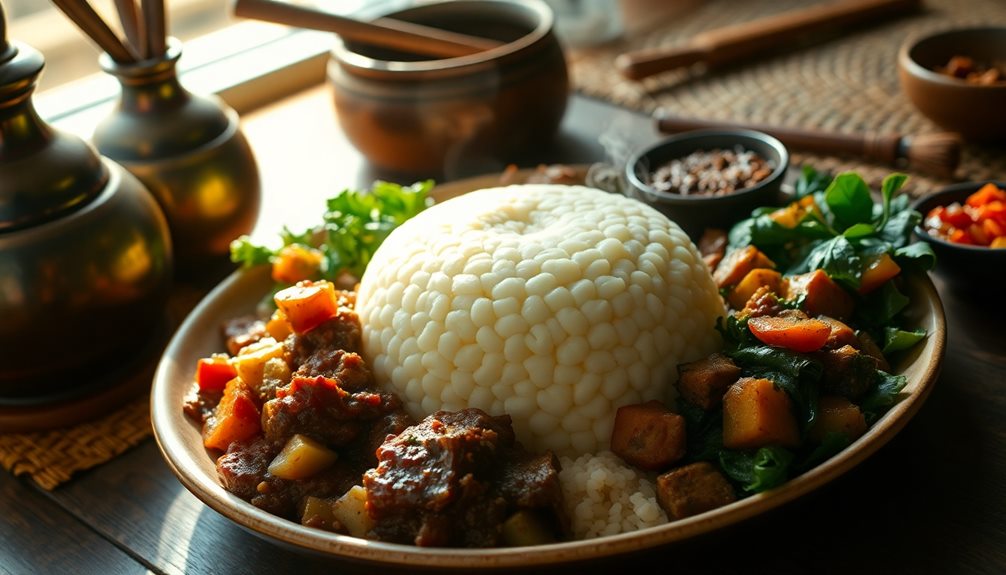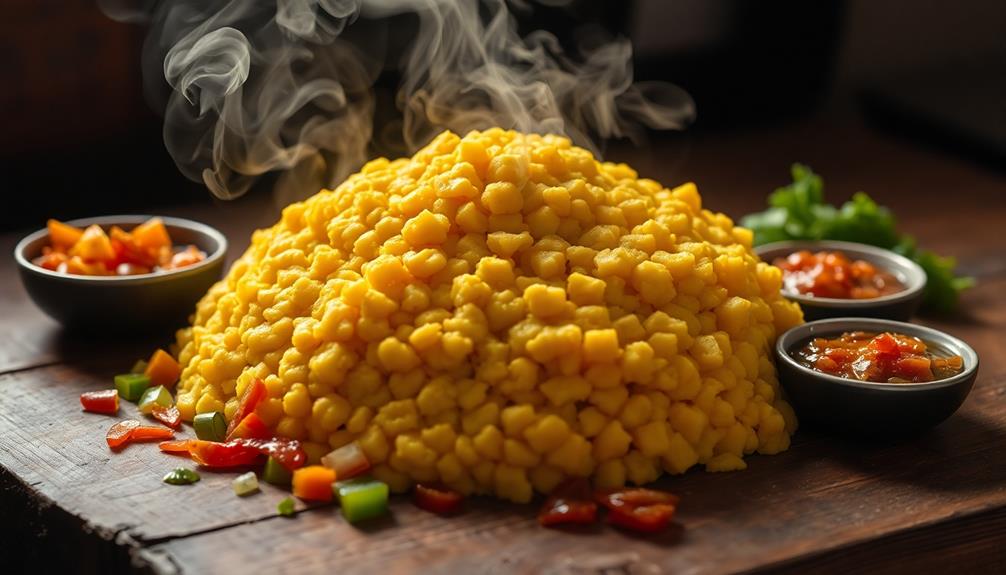When testing Zimbabwean sadza’s texture, you’ll find that fine maize meal creates a smooth, velvety consistency making the sadza more pliable and uniform. Coarse maize meal results in a chunkier, hearty feel with a rustic appearance. Fermentation can add a slight tang and deepen the flavor, especially with finer grains. Pay attention to these differences—they reveal much about regional traditions and personal preferences, and exploring deeper will uncover even more about this cherished staple.
Key Takeaways
- Fine maize meal produces a smooth, velvety sadza, while coarse meal results in a chunkier, rustic texture.
- Texture differences influence how sadza is molded, served, and enjoyed with relishes.
- Fermentation enhances flavor and aroma, with finer maize meal showing more pronounced fermentation effects.
- Personal and regional preferences dictate whether a silky or hearty texture is preferred.
- Texture testing reveals the traditional significance and diversity of Zimbabwean sadza preparation methods.

Sadza is the heart of Zimbabwean cuisine, serving as a staple food that brings families and communities together. Whether you’re sitting around a communal table or sharing a meal with loved ones, the texture of your sadza plays a crucial role in the experience. When preparing sadza, you’ll notice that the type of maize meal you use—either fine or coarse—makes a significant difference in how it turns out. The choice impacts not only the look and feel but also the traditional serving methods and the overall taste.
Sadza’s texture, whether fine or coarse, shapes its taste, tradition, and cultural significance in Zimbabwean cuisine.
In Zimbabwe, the fermentation process is sometimes involved in preparing maize meal, especially when making sour sadza. This fermentation adds a slight tang and depth of flavor, and it can influence whether you prefer a finer or coarser texture. The fermentation process is natural and allows the maize to develop a richer aroma and taste, which can be more pronounced in finely milled maize meal. When you cook sadza, the texture is largely determined by the grind size; fine maize meal produces a smoother, more velvety consistency, while coarse maize meal results in a chunkier, more textured feel. Both types are traditional, but the preference varies across regions and households.
Traditional serving methods also influence how you experience sadza’s texture. Typically, sadza is molded into a dense ball and served with a variety of relishes, such as vegetables, meats, or beans. If you’re using fine maize meal, the sadza tends to be more pliable and easier to mold, allowing for a neat, uniform presentation. Coarse maize meal, on the other hand, creates a more rustic appearance, with a hearty texture that holds up well when dipped into flavorful sauces or stews. The way you eat sadza—using your fingers to pinch off a piece and scoop up relish—also emphasizes the importance of its texture. A finer sadza feels smooth and soft on the tongue, while coarse sadza provides more bite and substance.
Ultimately, your choice between fine and coarse maize meal boils down to personal preference and the traditional methods you follow. Some enjoy the silky smoothness of fine sadza, especially when paired with delicate or spicy dishes, while others prefer the hearty, textured experience of coarse sadza, which adds a rustic touch to the meal. Additionally, the fermentation process can subtly influence the flavor profile and texture, making the sadza more complex and aromatic. Whichever you choose, understanding the fermentation process and traditional serving methods helps you appreciate the cultural significance and the subtle differences that make Zimbabwean sadza a unique and cherished staple.
Frequently Asked Questions
How Does Maize Meal Texture Affect Sadza’s Taste?
You might notice that maize meal texture considerably impacts sadza’s taste. Coarse maize meal can give sadza a grainier, more rustic flavor, while fine maize meal creates a smoother, milder taste. The maize texture influences how the flavors meld during cooking, affecting the overall flavor impact. By choosing the right maize texture, you can enhance your sadza’s flavor profile to suit your preference, making each meal more enjoyable.
What Are the Health Benefits of Fine vs. Coarse Maize Meal?
When considering the health benefits of fine versus coarse maize meal, you should know that nutritional differences are minimal, but digestibility factors matter. Fine maize meal is easier to digest, which can benefit your digestive health, especially if you have sensitive stomachs. Coarse meal retains more fiber, aiding digestion and promoting fullness. Choose based on your dietary needs, but both offer essential nutrients for your overall health.
Can Texture Influence Sadza’s Traditional Serving Methods?
You might notice that texture perception influences how sadza is traditionally served. A finer maize meal creates a smoother, more uniform consistency, enhancing the serving presentation and making it easier to mold and eat. Conversely, coarser meal provides a chunkier feel, which can affect the tactile experience and how people perceive the dish. So, your choice of texture directly impacts both the visual appeal and the overall enjoyment of sadza.
Are There Regional Preferences for Maize Meal Textures in Zimbabwe?
Ever wondered if your region has a secret preference? When it comes to maize meal textures, regional preferences in Zimbabwe do matter. Some areas favor the coarse, hearty meal that offers a robust bite, while others prefer the fine, smooth consistency for a softer, more refined sadza. These local tastes shape how you enjoy your sadza daily, revealing the rich cultural diversity woven into Zimbabwean cuisine.
How Does Cooking Time Vary Between Fine and Coarse Maize Meal?
You’ll notice that cooking duration varies between fine and coarse maize meal. Fine meal typically requires less time because its smaller particles absorb water and heat faster, leading to a quicker cook. Coarse maize meal, on the other hand, has a longer cooking duration due to larger particles, which influence the texture by needing more time to soften fully. This texture influence determines how long you should cook each type for the best sadza.
Conclusion
As you savor each bite of sadza, remember it’s more than just maize; it’s a symbol of unity and tradition. The texture reveals the heart of your culture—fine or coarse, it reflects your connection to heritage and community. Whether smooth or rough, each meal binds you to ancestors who shaped these flavors. Embrace the texture as a reminder that, like life, it’s the imperfect moments that nourish your spirit and keep your traditions alive.
